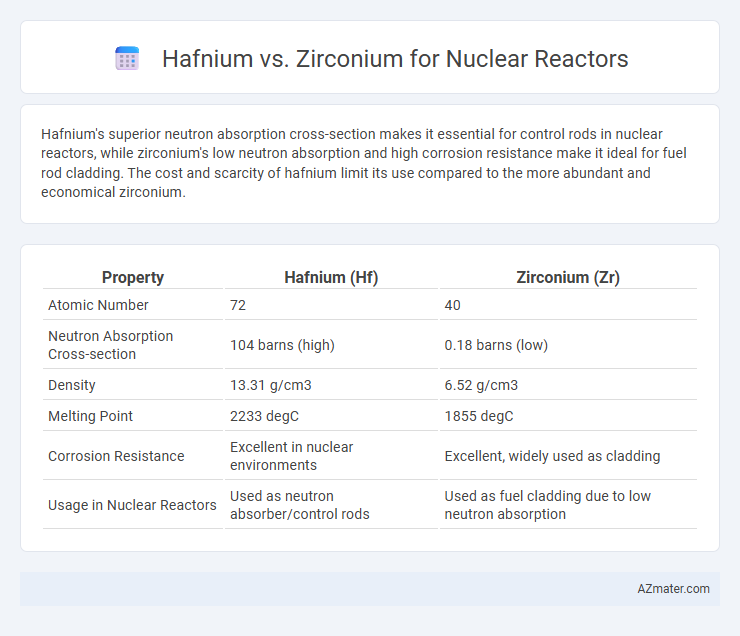Hafnium's superior neutron absorption cross-section makes it essential for control rods in nuclear reactors, while zirconium's low neutron absorption and high corrosion resistance make it ideal for fuel rod cladding. The cost and scarcity of hafnium limit its use compared to the more abundant and economical zirconium.
Table of Comparison
| Property | Hafnium (Hf) | Zirconium (Zr) |
|---|---|---|
| Atomic Number | 72 | 40 |
| Neutron Absorption Cross-section | 104 barns (high) | 0.18 barns (low) |
| Density | 13.31 g/cm3 | 6.52 g/cm3 |
| Melting Point | 2233 degC | 1855 degC |
| Corrosion Resistance | Excellent in nuclear environments | Excellent, widely used as cladding |
| Usage in Nuclear Reactors | Used as neutron absorber/control rods | Used as fuel cladding due to low neutron absorption |
Introduction to Hafnium and Zirconium in Nuclear Applications
Hafnium and zirconium are chemically similar transition metals, but their nuclear properties make them distinct in reactor applications. Zirconium's low neutron capture cross-section enables its use as cladding material for fuel rods, ensuring minimal interference with the nuclear reaction. Hafnium's high neutron absorption capacity makes it ideal for control rods, allowing precise regulation of reactor neutron flux and reactor power.
Chemical and Physical Properties Comparison
Hafnium and zirconium both exhibit similar chemical properties due to their position in the periodic table, yet hafnium has a much higher neutron absorption cross-section, making zirconium the preferred choice for nuclear reactor cladding to minimize neutron capture. Physically, hafnium has a higher density and melting point than zirconium, contributing to its superior corrosion resistance but increased weight, which affects reactor efficiency. Zirconium's low thermal neutron capture rate combined with good mechanical strength and corrosion resistance under reactor conditions makes it ideal for maintaining fuel integrity and reactor safety.
Abundance and Sourcing of Hafnium and Zirconium
Hafnium and zirconium are chemically similar but differ significantly in abundance and sourcing, influencing their roles in nuclear reactors. Zirconium is abundant in the Earth's crust, primarily sourced from zircon mineral deposits, making it widely available and cost-effective for nuclear applications due to its low neutron absorption cross-section. Hafnium, rarer and often found alongside zirconium in mineral deposits, requires complex extraction processes to separate it, which limits its availability and raises costs despite its critical role in control rods due to its high neutron absorption capabilities.
Neutron Absorption Capabilities
Hafnium exhibits exceptional neutron absorption capabilities due to its high neutron capture cross-section, making it ideal for control rods in nuclear reactors. Zirconium, in contrast, has a very low neutron absorption cross-section, which is why it is commonly used as fuel cladding material to minimize neutron loss. The contrasting neutron interaction properties of hafnium and zirconium optimize reactor efficiency and safety by balancing neutron economy and control.
Corrosion Resistance in Nuclear Environments
Hafnium exhibits superior corrosion resistance compared to zirconium in nuclear reactor environments due to its dense oxide layer, which enhances protection against high-temperature water and radiation-induced damage. Zirconium's lower neutron absorption cross-section makes it favorable for fuel cladding, but its corrosion resistance is compromised under aggressive reactor conditions, leading to hydride formation and embrittlement. Combining hafnium's corrosion resistance with zirconium's neutron transparency is a key factor in advanced nuclear reactor material design.
Roles in Nuclear Reactor Components
Hafnium and zirconium play critical but distinct roles in nuclear reactor components due to their unique nuclear and physical properties. Hafnium is primarily used for control rods because of its excellent neutron absorption capability, which helps regulate the fission process and maintain reactor safety. Zirconium is favored for cladding fuel rods because of its low neutron absorption cross-section and high corrosion resistance, ensuring structural integrity and efficient neutron economy within the reactor core.
Fabrication and Processing Differences
Hafnium and zirconium exhibit significant differences in fabrication and processing for nuclear reactors due to their distinct chemical and physical properties. Hafnium's high neutron absorption cross-section necessitates careful separation from zirconium during ore processing to ensure reactor-grade zirconium purity. Zirconium's corrosion resistance and low neutron absorption enable easier fabrication into cladding materials, while hafnium's density and brittleness require specialized handling and alloying techniques to optimize performance in control rods.
Safety and Performance Considerations
Hafnium's high neutron absorption cross-section makes it essential for control rods, enhancing nuclear reactor safety by effectively regulating fission reactions. Zirconium, with its low neutron absorption and excellent corrosion resistance, is preferred for fuel cladding, ensuring reactor performance under high-temperature and radiation conditions. The combination of hafnium's neutron control capabilities and zirconium's structural stability optimizes reactor efficiency and safety margins.
Cost and Economic Factors
Hafnium and zirconium are critical materials in nuclear reactors, with zirconium widely used for fuel cladding due to its low neutron absorption and relatively lower cost. Hafnium's high neutron absorption capacity makes it ideal for control rods but significantly increases its price, often by several orders of magnitude compared to zirconium, impacting reactor maintenance budgets. Economic decisions in reactor design prioritize zirconium for bulk applications while reserving hafnium for specialized roles where performance justifies the higher expense.
Future Trends in Nuclear Material Selection
Hafnium and zirconium are critical elements in nuclear reactor materials due to their neutron absorption and corrosion resistance properties. Future trends in nuclear material selection emphasize the use of zirconium alloys for cladding because of their low neutron absorption cross-section, while hafnium's superior neutron capture capabilities make it valuable for control rods and neutron shielding. Advances in material science aim to optimize the balance between these elements to enhance reactor safety, efficiency, and longevity in next-generation nuclear systems.

Infographic: Hafnium vs Zirconium for Nuclear Reactor
 azmater.com
azmater.com